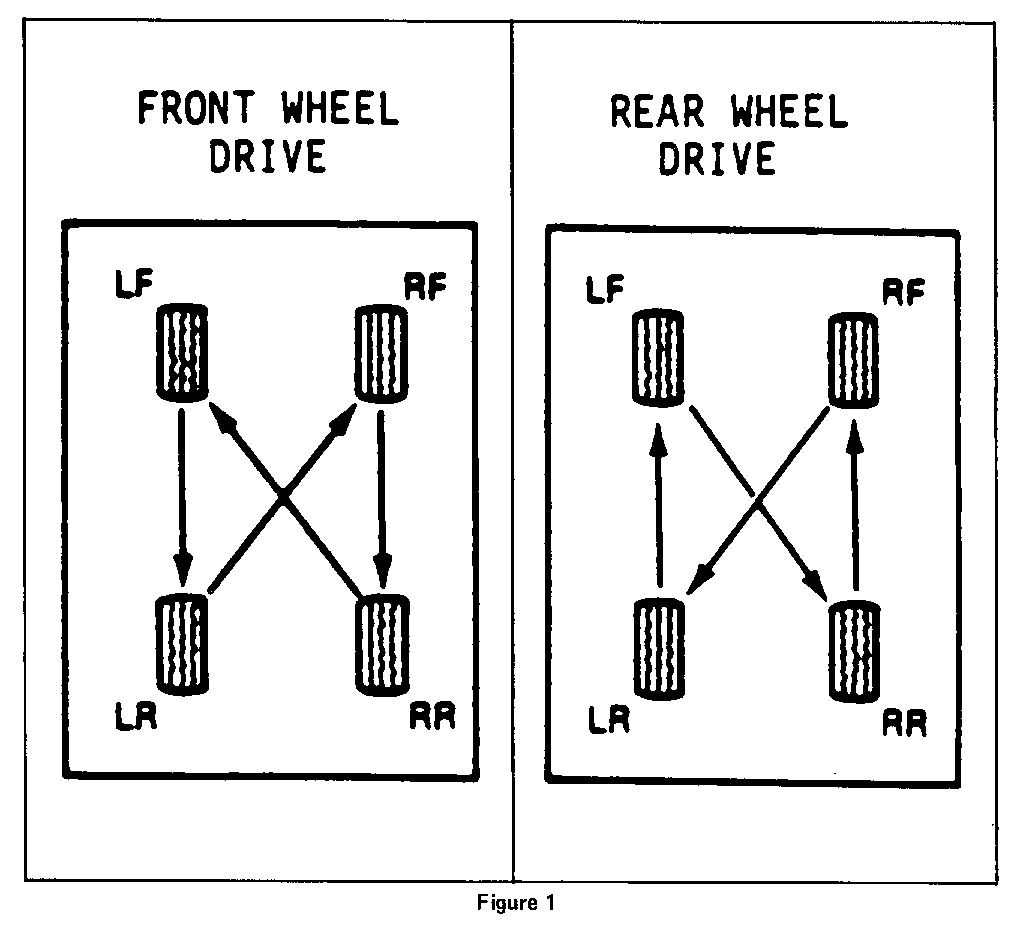FRONT POSITION TIRE WEAR RWD. VEHICLES (ROTATION)

IRREGULAR TIRE WEAR
ALL MODELS
Front Position Tire Wear on Rear-Wheel-Drive Vehicles With All Season Tires
Some rear-wheel-drive vehicles may exhibit premature tire wear on the front tires. The wear usually starts on the outer tread row and may progress across the full tread. This wear also usually appears as a heel and toe (high and low) wear pattern on individual tread blocks which can eventually lead to tire noise and/or tire roughness.
Small amounts of heel/toe wear on the outer tread is considered normal. This wear is characteristic of new tires at full tread depth on free-rolling axles. Turning and cornering exaggerates front tire wear. Routine tire rotation at 7,500 miles using the modified "X" method as shown in the Owner's Manual will minimize the wear. Such tires can be expected to give optimum performance for their full intended life.
If this type of wear becomes excessive and/or results in a customer inquiry, the following procedure should be used:
1. Rotate tires using the modified "X" pattern shown in Figure 1. This allows the front tires to wear in the opposite direction on the rear of the vehicle which will tend to even out any irregular wear quicker. It also allows all four tires to eventually run on all four positions. Tire noise may continue after rotation, but should gradually lessen after a few thousand miles.
2. Measure front wheel alignment. The single most contributing cause of premature tire wear, except for abusive driving, is excessive toe. For best tire wear, reset toe as close to zero as the specification allows. in most cases, this will be .1 DEG total toe or less. Camber and caster should also be set to specification if necessary.
3. Talk to the customer about their tires. Explain that some amount of shoulder wear on front tires is normal and will even out with regular tire rotation. Explain that front tire shoulder wear is also exaggerated by hard cornering. Stress the importance of proper inflation pressure and wheel alignment.
4. If the wear has advanced far enough, tire replacement may become necessary. When installing new tires, match the tire's high point mark to the wheel's valve and then balance. Also, wheel alignment must be reset as specified in Stop 2 above and the customer instructed to follow the modified "X" rotation schedule at 7,500 miles.
Irregular Rear Tire Wear - 1984-86 Cutlass Ciera
Some 1984-86 Cutlass Ciera models may develop an irregular wear pattern on the rear tires. This condition may cause tire noise and/or tire roughness due to the heel and toe (high and low) wear pattern on individual tread blocks. A diagonal wear pattern may also become evident across the face of the tread.
Excessive toe-in of the rear axle will increase irregular rear tire wear. The rear axle toe-in specification is 0 DEG + or - 2 DEG. To correct excessive rear axle toe-in, install shim kit, part number 14094481. Installation of the two shims in the kit, one at each, axle end, will reduce toe-in by .4 DEG. Follow instructions included in kit for proper installation.
CAUTION:
Use only GM part number 14094481 shim kit. Use of other parts may cause bolt torque loss which could result in the loss of a wheel and resulting damage and/or personal injury.
If tires are replaced, put the two (2) new tires on the front and move the front tires to the rear position. After 7,500 miles, tires should be rotated following the modified "X" pattern. See Figure 1.
If the tires are not replaced, rotate the tires using the modified "X" pattern. This will tend to even out normal heel/toe tread wear.
PARTS INFORMATION
One (1) shim kit part number 14094481. Kit includes: Two (2) shims (part number l4094467) Eight (8) bolts (part number 25519720) One (1) instruction sheet (part number 14094482)
WARRANTY INFORMATION
Trouble Code Labor Operation Labor Hours ------------ --------------- ----------- 92 T1141 .7

General Motors bulletins are intended for use by professional technicians, not a "do-it-yourselfer". They are written to inform those technicians of conditions that may occur on some vehicles, or to provide information that could assist in the proper service of a vehicle. Properly trained technicians have the equipment, tools, safety instructions and know-how to do a job properly and safely. If a condition is described, do not assume that the bulletin applies to your vehicle, or that your vehicle will have that condition. See a General Motors dealer servicing your brand of General Motors vehicle for information on whether your vehicle may benefit from the information.
